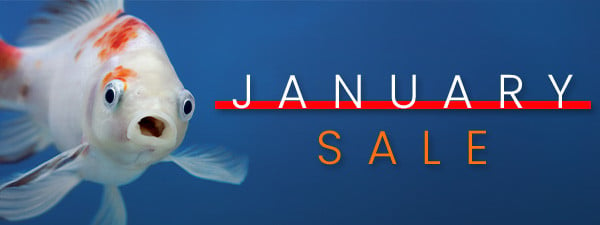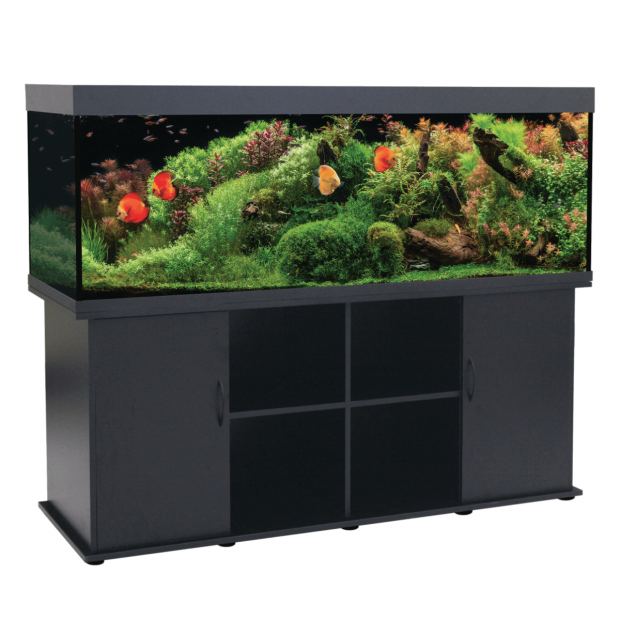- Colours, patterns, and size may vary
- Grow to max sizes of ~20cm
- Require more care than Common Goldfish
Please check the delivery dates below before placing your order.
Overview
Everything you need to know about Red and White Oranda Goldfish, at a glance:
- Common Names: Hooded Goldfish, Bullhead Goldfish
- Scientific Name: Carassius auratus
- Max Size: ~20cm
- Temperature Range: 18-25°C
- pH Range: 6.0-8.0, though 7.5 is ideal
- Compatibility: Peaceful, though best suited to species-only aquariums
- Area Of Origin: China
- Suitable Foods: Variety of flakes, sticks and pellets
- Special Requirements: Need a lot of fibre in their diets to combat common digestive problems
What is a Red and White Oranda Goldfish?
There are more than 100 types of Fancy Goldfish, and Orandas are amongst the most popular. These fish are technically goldfish, Carassius auratus, though they've been specially bred to look very different than their more common cousins.
Orandas are characterised by their stout bodies, long, trailing fins and a prominent, bubble-like Ëœhood' (sometimes known as a wen) on their heads. They come in many different sizes and colours, from small to giant and platinum to chocolate. This red and white colour morph has splotches of red and white across its body, including on its head.
Some Orandas develop huge hoods as they age, and these are known as Jelly Head Orandas. These are some of the most sought-after fish in the Fancy Goldfish hobby the larger and more colourful the hood, the more sought after they are!
Not much is known about the origin of Orandas, but it's thought that they were one of the first types of Fancy Goldfish to be created by breeders in China. Other types of Fancy Goldfish include Ryukins, Ranchus, Pearlscales, and Telescopes. All of these varieties are available to purchase from Swell UK.
How do I care for Red and White Oranda Goldfish?
Orandas, just like other types of Fancy Goldfish, require a moderate level of care. They're not quite as hardy as their Common Goldfish cousins and do best in large, heated aquariums, rather than outdoor garden ponds. Some Fancy Goldfish keepers do choose to keep their goldfish outside in large, raised tubs/ponds during the summer months, however.
A single Oranda needs at least 75 litres of space, though more is always better. They also benefit from a heater, despite being known as ˜coldwater' fish. They don't require a lot of heat, but stable temperatures of ~20°C will keep them in tip-top health and help their bodies go through all of their natural biological processes. On hotter days where room temperatures exceed 20°C, heaters can be switched off to cut down on energy spend.
Like other types of Fancy Goldfish, Orandas eat a lot of food and produce a lot of waste. For this reason, they need to be kept in an aquarium equipped with a powerful filtration system. The best kind of filters for Fancy Goldfish aquariums are external canister filters. These are capable of filtering large aquariums upwards of 150 litres and can process large amounts of waste thanks to the huge amount of mechanical, biological, and chemical media that you can pack into them.
Moreso than Common Goldfish, Orandas and other types of Fancy Goldfish suffer from digestive problems, like constipation. To ease this common problem and help your fish pass a blockage, offer them some high-fibre foods like blanched green peas. The most common cause of constipation in Fancy Goldfish is poor diet and overfeeding, but a lack of exercise (from being kept in a small aquarium) and water that's too cold can also contribute.
To avoid common digestive problems like constipation, it's important that you feed your Orandas some high-quality, specialist flakes/pellets. You can offer them some live foods now and again as a treat but be careful not to overfeed.
Orandas are best kept in small groups or with other types of Fancy Goldfish. Avoid keeping them with faster swimmers, like Common Goldfish, who can easily outcompete them for food. Also avoid keeping them with fish known to nip fins. Fancy Goldfish have long, trailing fins and as slow, clumsy swimmers they can quickly become easy targets for fin nippers.
How is this Red and White Oranda Goldfish delivered?
All of our aquatic animals are dispatched from our livestock distributor and delivered directly to your doorstep. Our distributor dispatches and delivers livestock packages on Wednesday or Thursday to avoid animals being in transit over the weekend. To further minimise time spent travelling, all livestock deliveries are made before 1pm on the day of delivery.
After placing your livestock order, you'll receive all the information needed to track your livestock order via email. If you have any problems regarding delivery, or concerns about the health/wellbeing of your animal(s) upon arrival, please contact us, Swell UK Ltd, immediately, or at least within 48 hours of receiving your livestock order.
Any other, non-livestock items that you purchase alongside livestock will be sent via standard or express delivery and arrive at your delivery address in a different package. This means that, depending on when you place your order, you may receive your non-livestock items before or after your livestock package.
For a detailed breakdown of when you can expect to receive your livestock package depending on the day you placed your order, be sure to check the delivery details in the specifications below.
How do you acclimate a Red and White Oranda Goldfish to an aquarium?
It's very important that you acclimatise new fish to your aquarium. This is the process of gradually adjusting an animal to its new environment and it's especially important in an aquatic setting where sudden changes in water temperature, pH, and nitrates can cause stress, illness and, in some cases, even death.
To acclimate your new fish, place the bag into an empty bucket and open it. Then, add a small amount of aquarium water to your bucket every few minutes until the water temperature in the bucket matches the water temperature in your aquarium. Do this for at least 20 minutes.
If you don't have a bucket to hand, then you can simply float the bag containing your new fish in your aquarium. If you're adding your fish to an aquarium, always turn off your lights to reduce stress. Also, avoid adding dirty water from the bag into your aquarium by netting your fish.
You should always set up your aquarium and make sure it's ready for fish prior to purchasing any. It's also a good idea to let your filter mature for a week or two before adding fish. A single Oranda can produce a lot of mess; your filter needs to be able to handle this if it's to maintain a healthy environment. For more information about how to set up an aquarium for Fancy Goldfish, check out our help guide here.
Above photos are for illustration purposes only; livestock received may not exactly match those photographed.
Please note: The livestock that is sold on our online site is not held in store at our Swell shop, or available for collection from the shop. Species sold at our Swell store will differ from ones available to order to your door.
All livestock deliveries are subject to our full Delivery Terms & Conditions, please read before ordering.
| Order Livestock By | Receive Order By |
| Monday 11:30am | Wednesday |
| Tuesday 11:30am | Thursday |
| Wednesday 11:30am | Friday |
| Thursday 11:30am | Saturday |
| Friday | Wednesday |
| Saturday | Wednesday |
| Sunday | Wednesday |
-
 Red & Black Oranda Goldfish Carassius AuratusFrom £10.00In stock
Red & Black Oranda Goldfish Carassius AuratusFrom £10.00In stock -
 Red Cap Oranda Goldfish Carassius AuratusFrom £10.00In stock
Red Cap Oranda Goldfish Carassius AuratusFrom £10.00In stock -
 White Oranda Goldfish Carassius AuratusFrom £10.00In stock
White Oranda Goldfish Carassius AuratusFrom £10.00In stock -
 Pink Black Eye Oranda Goldfish Carassius AuratusFrom £10.00In stock
Pink Black Eye Oranda Goldfish Carassius AuratusFrom £10.00In stock -
 Assorted Oranda Goldfish Carassius AuratusFrom £8.00In stock
Assorted Oranda Goldfish Carassius AuratusFrom £8.00In stock
















